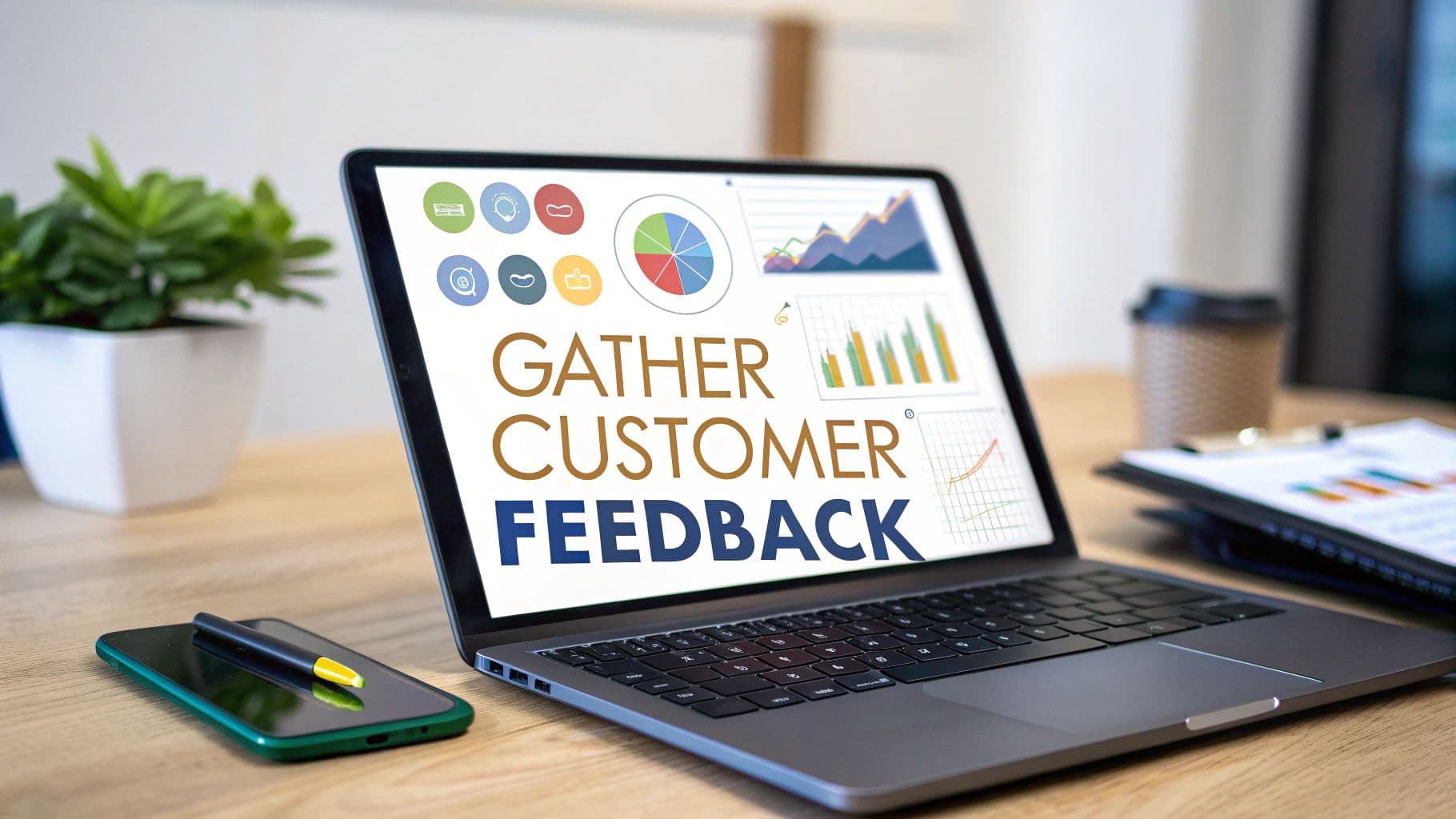How to Gather Customer Feedback That Drives Growth
Learn how to gather customer feedback effectively. Discover the right channels, tools, and workflows to transform insights into measurable business growth.

Collecting customer feedback sounds simple enough, right? You ask customers what they think, and then you use their answers to make things better. In practice, the best strategies are a mix of proactive channels (like sending out a survey) and reactive listening (like keeping an eye on social media and review sites). This way, you capture both the specific answers you're looking for and the spontaneous, unfiltered opinions people share on their own.
Why Customer Feedback Is Your Greatest Asset
It's easy to think of customer feedback as just a tool for putting out fires. But the companies that are really winning see it differently. They treat customer insights as a strategic compass for innovation, retention, and building a brand people love.
Ignoring what your customers are trying to tell you isn't just a missed opportunity—it's a direct threat to your business. It leads to higher churn, a tarnished reputation, and a product that gradually becomes irrelevant to the very people it's supposed to serve.
When you build a culture that actively seeks out and acts on customer input, you create a powerful engine for sustainable growth.
The True Cost of Ignoring Customers
The numbers don't lie. Neglecting feedback hits your bottom line, hard. A recent Forrester analysis uncovered a pretty worrying trend: for every brand that got better at customer experience (CX), more than three got worse.
To be specific, 21% of brands saw their CX scores drop, while only 6% managed to improve them. This gap shows just how tough it is out there. It also proves that even small improvements, guided by what customers are telling you, can make a huge difference in keeping them around and encouraging them to spend more. You can dig into the full details in Forrester's 2025 CX Index research.
This is exactly why having a solid system for how to gather customer feedback that actually drives growth is no longer a nice-to-have. It’s a core business function.
Feedback as a Growth Engine
When you get it right, that steady stream of customer feedback becomes your roadmap to success. It’s what helps you:
- Innovate with confidence. You stop guessing and start building features that solve actual problems.
- Improve retention. You can spot customers who are unhappy and address their issues before they decide to walk away.
- Align internal teams. Everyone from product to sales gets on the same page. This is especially true for product marketing, which relies on a deep understanding of what customers truly value. You can learn more about this in our guide on what does product marketing do.
- Build a stronger brand. Showing customers you're listening is one of the most powerful ways to build loyalty and turn them into advocates.
Where to Find Quality Customer Feedback
Figuring out the best places to gather customer feedback can feel like trying to drink from a firehose. There are dozens of potential channels, and it's easy to get overwhelmed. The secret isn't to be everywhere at once. Instead, build a smart listening strategy that blends both proactive and reactive methods. This way, you’re not just getting answers to your own questions but also tuning into the honest, unfiltered opinions your customers share on their own terms.
This visual really brings home the core decision every business faces when feedback comes in: act on it and grow, or ignore it and watch customers walk away.

As the infographic makes clear, acting on what you learn is a direct path to better business outcomes. Neglecting it? That’s a surefire way to increase churn.
Comparing Popular Customer Feedback Channels
To make sense of the options, it helps to see them side-by-side. Each channel has its own strengths, depending on whether you want broad quantitative data or deep qualitative insights.
| Channel | Type | Best For | Implementation Effort |
|---|---|---|---|
| Surveys (NPS, CSAT, CES) | Proactive | Measuring satisfaction and loyalty at scale | Low to Medium |
| User Interviews | Proactive | Deep-diving into user motivations and pain points | High |
| In-App Feedback Forms | Proactive | Capturing contextual feedback in real-time | Low to Medium |
| Social Media | Reactive | Monitoring brand sentiment and candid opinions | Medium |
| Online Review Sites | Reactive | Understanding competitor strengths and weaknesses | Medium |
| Support Tickets | Reactive | Identifying recurring product bugs and frustrations | Low |
This table isn't exhaustive, but it shows how different channels serve different purposes. A good strategy will pull from both proactive and reactive columns to build a complete picture of the customer experience.
Proactive Channels: Starting the Conversation
Proactive channels are all about you initiating the conversation. You get to control the questions, the timing, and the audience, which makes them perfect for gathering structured data on specific parts of your product or service.
Think of these as your go-to research tools for targeted insights.
- Targeted Surveys (NPS, CSAT, CES): These are the workhorses of quantitative feedback. CSAT (Customer Satisfaction) is great for a quick check-in right after an interaction, while CES (Customer Effort Score) tells you how easy—or difficult—it was for a customer to get something done. And of course, NPS (Net Promoter Score) gives you that high-level view of overall brand loyalty.
- User Interviews: For digging deep into the "why" behind customer behavior, nothing beats a real conversation. These one-on-one chats let you ask follow-up questions and uncover the nuances that surveys just can't capture.
- In-App Feedback Forms: Placing a simple feedback widget or form right inside your app is a brilliant way to get contextual feedback. Someone’s frustrated with a feature? They can tell you right then and there. This is especially powerful for collecting new ideas, which you can manage with a dedicated request a feature page.
A neat trick for bridging the physical and digital worlds is using QR codes. If you have a retail space or use printed materials, you can easily generate QR codes for Google Forms and make leaving feedback completely seamless for your customers.
Reactive Channels: Listening In on the Conversation
Reactive channels are about tuning into conversations that are already happening out in the wild. This is where you'll find the most candid, spontaneous, and sometimes brutally honest feedback. You aren't guiding the discussion here; you're just listening and learning.
These channels give you an unfiltered look at how people truly perceive your brand.
The cost of not listening is staggering. Globally, poor customer experiences contribute to an estimated $4.7 trillion in lost sales every single year, and a huge chunk of that comes from feedback that simply falls on deaf ears. It's wild to think that nearly half of all customer complaints on social media are never even addressed.
Here are a few key reactive channels to monitor:
- Social Media Listening: Platforms like X (formerly Twitter), LinkedIn, and Reddit are absolute goldmines of raw opinion. By keeping an eye on brand mentions, key hashtags, and industry chatter, you can spot emerging trends and shifts in public sentiment before they become major issues.
- Online Review Sites: If you're a SaaS or tech company, sites like G2, Capterra, and TrustRadius are non-negotiable. The reviews there are often incredibly detailed, packed with feedback on everything from product features to the quality of your onboarding process.
Selecting Your Feedback Collection Toolkit
Once you’ve figured out where you’re going to collect feedback, you need to decide how. Manually copying and pasting comments into a spreadsheet might feel productive for a week, but it quickly spirals into a bottleneck. You’ll spend all your time wrangling data and no time actually understanding it.
The right toolkit automates the tedious parts, freeing you up to focus on what your customers are really telling you. There’s a whole world of options out there, from dedicated survey software like SurveyMonkey to all-in-one platforms like Hotjar that mix feedback with user behavior analytics. The key isn't finding the tool with the longest feature list; it's about finding the one that slots into your existing workflow and solves your most pressing problems.
Key Criteria for Choosing Feedback Tools
As you start looking at different platforms, focus on three things: how well it integrates with other tools, how deep its analytics go, and whether your team will actually want to use it. A powerful tool that gathers dust is worse than a simple one that gets used every day.
Keep these essentials in mind:
- Seamless Integrations: Does it play nice with your other systems? You need it to connect directly to your helpdesk (Zendesk, Intercom), your CRM (Salesforce), and your development trackers (Jira, Linear). If you’re manually moving data between systems, you’re creating opportunities for errors and delays.
- Analytical Power: You need more than just a data dump. Look for features like sentiment analysis, topic detection, and the ability to slice and dice feedback by customer segment, account value, or product line. This is where raw data becomes business intelligence.
- User-Friendly Interface: Your entire team—from frontline support to product leaders—should be able to log in and find what they need without a two-week training course.
The end goal is to build a connected system where feedback flows from the customer straight to the people who can do something about it, without friction.
The Rise of AI in Feedback Analysis
This is where things get really interesting. One of the biggest shifts in feedback management is the role of artificial intelligence. AI shines when it comes to making sense of messy, unstructured qualitative data—the kind you get from reviews, support tickets, and chat logs. It can automatically categorize thousands of comments by theme, pinpoint the underlying sentiment, and spot recurring issues a human analyst might easily overlook.
This is especially critical now. Live chat is the go-to support channel for 41% of consumers, and many companies are banking on AI to handle a growing chunk of those interactions. This trend makes AI-powered tools a necessity, not a luxury. They’re what allow you to process feedback at scale and turn a flood of raw conversation into structured, actionable insights.
This diagram gets it right—collection is just the starting line. It's the analysis and implementation that close the loop and actually drive meaningful improvements for your product and your customers.
Ultimately, your toolkit should help you move beyond simply collecting scores and comments. To dig deeper into what to look for, check out our guide on the top customer feedback analysis tools that can help you find the signal in the noise.
Building a System to Analyze and Act on Feedback

Collecting feedback without a clear plan to use it is like hoarding ingredients with no recipe. You’ve got the raw materials, but you’re not making a meal. The real magic happens when you build a repeatable system that turns customer comments into real-world business actions. This is what separates companies that merely react to problems from those that proactively build what customers actually want.
A solid system doesn't have to be overly complex. It just needs to be consistent. This ensures every valuable insight is captured, properly understood, and routed to the person who can actually do something about it.
Centralize and Categorize Every Piece of Feedback
The first thing you have to do is get all that feedback out of its various silos and into one place. Think about it: you've got G2 reviews, NPS surveys, support tickets, and notes from sales calls. If they're all living in different spreadsheets or getting lost in Slack channels, you're losing valuable data. A single source of truth is non-negotiable.
Once everything is in one spot, you need to start categorizing. This is more than just slapping on a few tags; it’s about creating a shared language across your company for what customers are telling you.
You can start with some broad, high-level themes:
- Bug Reports: Stuff that's just plain broken.
- Feature Requests: New ideas or improvements to existing tools.
- Usability Friction: Places where users get confused or stuck.
- Pricing/Billing Issues: Anything related to cost, plans, or invoices.
Prioritize Based on Business Impact
Let’s be honest: not all feedback is created equal. A feature request from a single user on a free plan doesn't carry the same weight as a recurring bug that's threatening to cause churn among your biggest enterprise customers. If you chase every shiny idea, you’ll never get anything important done.
You need a clear framework for prioritization that ties feedback directly to your business goals.
Imagine you have two issues. One is a minor UI tweak that a few customers have mentioned. The other is a bug that has popped up in 20% of support tickets from your highest-paying clients this month. Suddenly, the choice of what to tackle first becomes crystal clear. An AI-powered platform like SigOS can do this heavy lifting for you, automatically quantifying the revenue impact of different bugs and requests. This lets you focus on the issues that are actively costing you money.
Assign Ownership and Close the Loop
With your feedback centralized and prioritized, the final pieces of the puzzle are assigning ownership and, crucially, communicating back. Every actionable piece of feedback needs a clear owner. Bugs go to engineering, usability problems go to the product design team—no ambiguity.
But the most important part? You have to close the loop.
When you finally ship a fix or launch a feature that a customer asked for, reach out to them! A simple, personal email saying, “Hey, you asked for this, and we built it,” is one of the most powerful loyalty-building tools you have. It shows your customers that you’re actually listening, not just collecting data. It turns feedback from a one-way street into a real conversation that builds lasting relationships.
Common Feedback Collection Mistakes to Avoid

Even with the best intentions, it's easy to stumble into common traps when gathering customer feedback. These missteps don't just waste your time and resources—they can frustrate customers and make them feel like you're not actually listening. Let's walk through a few of the biggest ones I've seen over the years.
One of the most common errors is asking leading questions. A survey that asks, "How much did you enjoy our new, streamlined checkout process?" is already pushing the user toward a specific answer. It assumes they found it both enjoyable and streamlined, which completely biases the data from the get-go. Instead of measuring their real experience, you're just fishing for compliments.
Then there's the issue of survey burnout. When a customer gets a feedback request after every single interaction—a support ticket, a small purchase, even logging in—they'll tune you out. This is especially true for long, complicated surveys that feel more like a chore than a quick check-in.
Ignoring the Uncomfortable Truths
This next one is maybe the most destructive mistake of all: selectively listening. It’s tempting to highlight the glowing reviews and high NPS scores, but the real growth opportunities are almost always buried in the negative feedback.
Think about it: when a customer takes the time to explain what went wrong, they're handing you a roadmap for improvement. They're showing you a problem that's probably affecting other, quieter customers too. Ignoring that criticism sends a powerful message that you only want to hear the good news. That’s a surefire way to alienate your most honest users and let small problems grow into deal-breakers.
Finally, the biggest mistake is simply collecting feedback with no plan to use it. If customer comments just end up in a spreadsheet that no one ever looks at again, you've wasted everyone's time—yours and theirs. Every feedback channel you open must connect directly to a process for review, analysis, and action. Otherwise, you're just creating noise.
Frequently Asked Questions About Customer Feedback
Even with a great strategy, some questions always come up once you start digging into customer feedback. Let's tackle some of the most common ones we hear from teams who are just getting their listening programs off the ground.
Think of this as your quick-reference guide for making sure your feedback process is working as hard as you are—and that you're respecting your customers' time along the way.
How Often Should We Ask Customers For Feedback?
The honest answer? It depends entirely on what you’re asking and when. The key is to match your request to the customer's journey.
For transactional feedback—think a quick survey after a support ticket is closed or an order is delivered—you want to ask right away. The memory is fresh, and the details will be much clearer.
But for relationship feedback, like a Net Promoter Score (NPS) survey, you should think more long-term. A quarterly or semi-annual rhythm is usually about right. It gives you a pulse on overall loyalty without bugging people. The golden rule is to avoid survey fatigue; make sure every single ask has a clear purpose.
What Is The Best Way To Handle Negative Customer Feedback?
First things first: don't see it as a problem. See it as a gift. It's a raw, unfiltered look into where you can get better, and that’s priceless.
Your first move should always be to respond quickly. If the feedback is public, like on Twitter or a review site, your first reply should also be public. It shows you're listening. Acknowledge their frustration, express empathy, and then—this is crucial—move the conversation to a private channel like DMs or email to solve the actual problem.
How Can A Small Business With Limited Resources Gather Feedback?
You don't need a six-figure budget to get started. Small businesses can get incredibly powerful insights by being scrappy and consistent.
- Lean on free tools: Google Forms is fantastic for creating simple, clean surveys that get the job done.
- Keep an eye on your digital storefront: Actively monitor and respond to comments on your social media pages and reviews on your Google Business Profile. This is where people get real.
- Create a passive "in": Just adding a simple "Got feedback?" link to your email signature can create a surprisingly steady stream of insights over time.
It’s not about having the fanciest software. It’s about building the habit of listening and, more importantly, acting on what you learn.
Ready to stop guessing and start quantifying the real-world impact of your customer feedback? SigOS uses AI to analyze support tickets, sales calls, and usage data, transforming qualitative noise into revenue-driving insights. See how it works and prioritize what to build next.
Keep Reading
More insights from our blog


